Petrology of the 1952 Eruption and Ancient Lava and Pyroclastic Flows of Krenitsyn Peak Volcano, Onekotan Island, Kuril Arc, Russia
Abstract
1. Introduction
2. Geological Setting
1952 Eruption
3. Materials and Methods
3.1. Materials
3.2. Methods
4. Results
4.1. Current State of the Volcano
4.2. Whole-Rock Geochemistry
4.3. Petrography
5. Discussion
5.1. Petrographic Signs of Magma Mingling
5.2. Variations in Lava Composition at Krenitsyn Peak over Time
5.3. Eruption on 11–19 November 1952
5.4. Further Research Directions: Krenitsyn Peak Volcano Resulting from the Post-Caldera Evolution of the Magmatic System of the Tao-Rusyr Volcano
6. Conclusions
Supplementary Materials
Author Contributions
Funding
Data Availability Statement
Acknowledgments
Conflicts of Interest
Correction Statement
References
- Gorshkov, G. Chronology of Eruptions of the Kuril Islands Volcanoes (1713–1952). In Proceedings of the Laboratory of Volcanology; USSR Academy of Sciences: Moscow, Russia, 1954. (In Russian) [Google Scholar]
- Polonsky, A. The Kuril Islands: Transactions of the Imperial Russian Geographical Society; Department of Ethnography: Moscow, Russia, 1871; Volume 4. (In Russian) [Google Scholar]
- Tatarninov, M. Description of the Kuril Islands: Historical and Geographical Almanac for 1785; Imperial Academy of Sciences: St. Petersburg, Russia, 1785. (In Russian) [Google Scholar]
- Bazanova, L.I.; Melekestsev, I.V.; Ponomareva, V.V.; Dirksen, O.V.; Dirksen, V.G. Late Pleistocene and Holocene Volcanic Catastrophes in Kamchatka and in the Kuril Islands. Part 1. Types and Classes of Catastrophic Eruptions as the Leading Components of Volcanic Catastrophism. J. Volcanol. Seismol. 2016, 10, 151–169. [Google Scholar] [CrossRef]
- Braitseva, O.A.; Melekestsev, I.V.; Ponomareva, V.V.; Sulerzhitsky, L. Ages of Calderas, Large Explosive Craters and Active Volcanoes in the Kuril-Kamchatka Region, Russia. Bull. Volcanol. 1995, 57, 383–402. [Google Scholar] [CrossRef]
- Derkachev, A.N.; Portnyagin, M.V. Marker Tephra Layers in the Late Quaternary Deposits of the Sea of Okhotsk as Evidence of Catastrophic Eruptions in the Nemo Caldera Complex (Onekotan Island, Kuril Islands). Stratigr. Geol. Correl. 2013, 21, 553–571. [Google Scholar] [CrossRef]
- Melekestsev, I.; Volynets, O.; Antonov, A.Y. Nemo III Caldera (Onekotan I., the Northern Kuriles): Structure, 14C Age, Dynamics of the Caldera-Forming Eruption, Evolution of Juvenile Products. Volcan. Seism 1997, 19, 41–64. [Google Scholar]
- Erlich, E. Geology of the Calderas of Kamchatka and Kurile Islands with Comparison to Calderas of Japan and the Aleutians, Alaska; US Geological Survey: Reston, VA, USA, 1986.
- Ishikawa, T.; Tera, F. Source, Composition and Distribution of the Fluid in the Kurile Mantle Wedge: Constraints from across-Arc Variations of B/Nb and B Isotopes. Earth Planet. Sci. Lett. 1997, 152, 123–138. [Google Scholar] [CrossRef]
- Zharinov, S.E. Petrochemical Variations of Island Arc Andesites (Kurile Island Arc). J. Geophys. Res. 1988, 93, 14828–14834. [Google Scholar] [CrossRef]
- Fedorchenko, V.; Abdurakhmanov, A.; Rodionova, R. Volcanism of the Kuril Island Arc: Geology and Petrogenesis. Nauka 1989, 237. [Google Scholar]
- Gorshkov, G. Chronology of Eruptions of Volcanoes in the Kurile Chain. Tr. Labratorii Vulkanol. 1954, 8, 58–99. [Google Scholar]
- Gorshkov, G. Active Volcanoes of the Kuril Island Arc. Arb. Vulk. Labor. Akad. Wiss. UdSSR 1958, 13, 5–70. [Google Scholar]
- Gorshkov, G. Volcanism of the Kuril Island Arc; Nauka: Moscow, Russia, 1967; Volume 288. [Google Scholar]
- Gorshkov, G.; Markhinin, E.; Rodionova, R.; Fedorchenko, V.; Shilov, V. A Description of Volcanoes on the Kuril Islands. In Geologiya SSSR: Kamchatka, Kuril’skie i Komandorskie Ostrova Geologicheskoe Opisanie; Nauka: Moscow, Russia, 1964; pp. 581–604. [Google Scholar]
- Markhinin, E.; Stratula, D. Some New Evidence on the Volcanism of the Kuril Islands. In Chetvertichnyi Vulkanizm Nekotorykh Raionov SSSR; Hayκa: Moscow, Russia, 1965; pp. 11–28. [Google Scholar]
- Piip, B.I.; Svyatlovskii, A.E. The 1952 Eruption of Krenitsyn Peak. Byul. Vulkanol. Stantsii 1954, 20, 64–68. [Google Scholar]
- Tomascak, P.B.; Widom, E.; Benton, L.D.; Goldstein, S.L.; Ryan, J.G. The Control of Lithium Budgets in Island Arcs. Earth Planet. Sci. Lett. 2002, 196, 227–238. [Google Scholar] [CrossRef]
- Sergeev, K.; Krasny, M. Geological and Geophysical Atlas of the Kuril-Kamchatka Island System; VSEGEI: Saint Petersburg, Russia, 1987; p. 36. [Google Scholar]
- Laverov, N.; Kovalenko, V.; Yarmolyuk, V.; Bogatikov, O.; Sakhno, V.; Gurbanov, A.; Kudryashova, E.; Akinin, V.; Evdokimov, A.; Pevzner, M. Recent Volcanism of Northern Eurasia: Regionalization and Formation Settings. Dokl. Earth Sci. 2006, 410, 1048–1052. [Google Scholar] [CrossRef]
- Nakagawa, M.; Ishizuka, Y.; Hasegawa, T.; Baba, A.; Kosugi, A. Preliminary Report on Volcanological Research of KBP 2007–2008 Cruise by Japanese Volcanology Group. KBP Rep. 2008, 54. [Google Scholar]
- Kozlov, D.N.; Degterev, A.V.; Zarochintsev, A.V. Koltsevoe caldera lake: Current state and structure of the basin (Onekotan Island, Kuril Islands). Geosyst. Transit. Zones 2018, 2, 359–364. [Google Scholar] [CrossRef]
- MacInnes, B.T.; Weiss, R.; Bourgeois, J.; Pinegina, T.K. Slip Distribution of the 1952 Kamchatka Great Earthquake Based on Near-Field Tsunami Deposits and Historical Records. Bull. Seismol. Soc. Am. 2010, 100, 1695–1709. [Google Scholar] [CrossRef]
- Gusiakov, V.K. Tsunamis on the Russian Pacific Coast: History and Current Situation. Russ. Geol. Geophys. 2016, 57, 1259–1268. [Google Scholar] [CrossRef]
- Jarosewich, E.; Nelen, J.A.; Norberg, J.A. Reference Samples for Electron Microprobe Analysis. Geostand. Newsl. 1980, 4, 43–47. [Google Scholar] [CrossRef]
- Basanina, A.E. Petrology of Volcanic Rocks from Tao-Rusyr, Onekotan, Kuril Islands. Bachelor’s Thesis, Department of Petrology and Volcanology, Faculty of Geology, Lomonosov Moscow State University, Moscow, Russia, 2025. Available online: https://istina.msu.ru/diplomas/791046977/ (accessed on 11 July 2025). (In Russian).
- Sun, S.-S.; McDonough, W.F. Chemical and Isotopic Systematics of Oceanic Basalts: Implications for Mantle Composition and Processes. Geol. Soc. Lond. Spec. Publ. 1989, 42, 313–345. [Google Scholar] [CrossRef]
- Hofmann, A.W. Chemical Differentiation of the Earth: The Relationship between Mantle, Continental Crust, and Oceanic Crust. Earth Planet. Sci. Lett. 1988, 90, 297–314. [Google Scholar] [CrossRef]
- Putirka, K.D. Thermometers and Barometers for Volcanic Systems. Rev. Mineral. Geochem. 2008, 69, 61–120. [Google Scholar] [CrossRef]
- Albarede, F. How Deep Do Common Basaltic Magmas Form and Differentiate? J. Geophys. Res. Solid Earth 1992, 97, 10997–11009. [Google Scholar] [CrossRef]
- Nelson, S.T.; Montana, A. Sieve-Textured Plagioclase in Volcanic Rocks Produced by Rapid Decompression. Am. Mineral. 1992, 77, 1242–1249. [Google Scholar]
- Vernon, R.H. A Practical Guide to Rock Microstructure; Cambridge University Press: Cambridge, UK, 2018; ISBN 1-108-68476-9. [Google Scholar]
- Davydova, V.O.; Shcherbakov, V.D.; Plechov, P.Y. The Timescales of Magma Mixing in the Plumbing System of Bezymianny Volcano (Kamchatka): Insights from Diffusion Chronometry. Moscow Univ. Geol. Bull. 2018, 73, 444–450. [Google Scholar] [CrossRef]
- Gerlach, D.C.; Grove, T.L. Petrology of Medicine Lake Highland Volcanics: Characterization of Endmembers of Magma Mixing. Contrib. Mineral. Petrol. 1982, 80, 147–159. [Google Scholar] [CrossRef]
- Ostorero, L.; Balcone-Boissard, H.; Boudon, G.; Shapiro, N.M.; Belousov, A.; Belousova, M.; Auer, A.; Senyukov, S.L.; Droznina, S.Y. Correlated Petrology and Seismicity Indicate Rapid Magma Accumulation Prior to Eruption of Kizimen Volcano, Kamchatka. Commun. Earth Environ. 2022, 3, 290. [Google Scholar] [CrossRef]
- Streck, M.J. Mineral Textures and Zoning as Evidence for Open System Processes. Rev. Mineral. Geochem. 2008, 69, 595–622. [Google Scholar] [CrossRef]
- Shcherbakov, V.D.; Plechov, P.Y.; Izbekov, P.E.; Shipman, J.S. Plagioclase Zoning as an Indicator of Magma Processes at Bezymianny Volcano, Kamchatka. Contrib. Mineral. Petrol. 2011, 162, 83–99. [Google Scholar] [CrossRef]
- Nixon, G.T.; Pearce, T. Laser-Interferometry Study of Oscillatory Zoning in Plagioclase; the Record of Magma Mixing and Phenocryst Recycling in Calc-Alkaline Magma Chambers, Iztaccihuatl Volcano, Mexico. Am. Mineral. 1987, 72, 1144–1162. [Google Scholar]
- Nakamura, M. Continuous Mixing of Crystal Mush and Replenished Magma in the Ongoing Unzen Eruption. Geology 1995, 23, 807–810. [Google Scholar] [CrossRef]
- Grove, T.; Juster, T.C. Experimental Investigations of Low-Ca Pyroxene Stability and Olivine-Pyroxene-Liquid Equilibria at 1-Atm in Natural Basaltic and Andesitic Liquids. Contrib. Mineral. Petrol. 1989, 103, 287–305. [Google Scholar] [CrossRef]
- Davydova, V.O.; Shcherbakov, V.D.; Plechov, P.Y.; Koulakov, I.Y. Petrological Evidence of Rapid Evolution of the Magma Plumbing System of Bezymianny Volcano in Kamchatka before the December 20th, 2017 Eruption. J. Volcanol. Geotherm. Res. 2022, 421, 107422. [Google Scholar] [CrossRef]
- Martel, C.; Pichavant, M.; Di Carlo, I.; Champallier, R.; Wille, G.; Castro, J.M.; Devineau, K.; Davydova, V.O.; Kushnir, A.R.L. Experimental Constraints on the Crystallization of Silica Phases in Silicic Magmas. J. Petrol. 2021, 62, egab004. [Google Scholar] [CrossRef]
- Sparks, R.S.J.; Annen, C.; Blundy, J.D.; Cashman, K.V.; Rust, A.C.; Jackson, M.D. Formation and Dynamics of Magma Reservoirs. Philos. Trans. R. Soc. A 2019, 377, 20180019. [Google Scholar] [CrossRef]
- Sparks, R.S.J.; Cashman, K.V. Dynamic Magma Systems: Implications for Forecasting Volcanic Activity. Elements 2017, 13, 35–40. [Google Scholar] [CrossRef]
- Ponomareva, V. Report on the 2008–2009 Work Within the Frames of the Kurile Biocomplexity Project; tDAR: Petropavlovsk-Kamchatsky, Russia, 2009; p. 391305. [Google Scholar] [CrossRef]
- Davydova, V.O.; Bindeman, I.N.; Shchekleina, M.D.; Rychagov, S.N. Pauzhetka Caldera (South Kamchatka): Exploring Temporal Evolution and Origin of Voluminous Silicic Magmatism. Petrology 2022, 30, 462–478. [Google Scholar] [CrossRef]
- Smirnov, S.Z.; Kotov, A.A.; Bergal-Kuvikas, O.V.; Degterev, A.V. Late Pleistocene–Holocene Caldera-Forming Explosive Volcanism of the Great Kuril Arc. Russ. Geol. Geophys. 2025, 66, 657–675. [Google Scholar] [CrossRef]
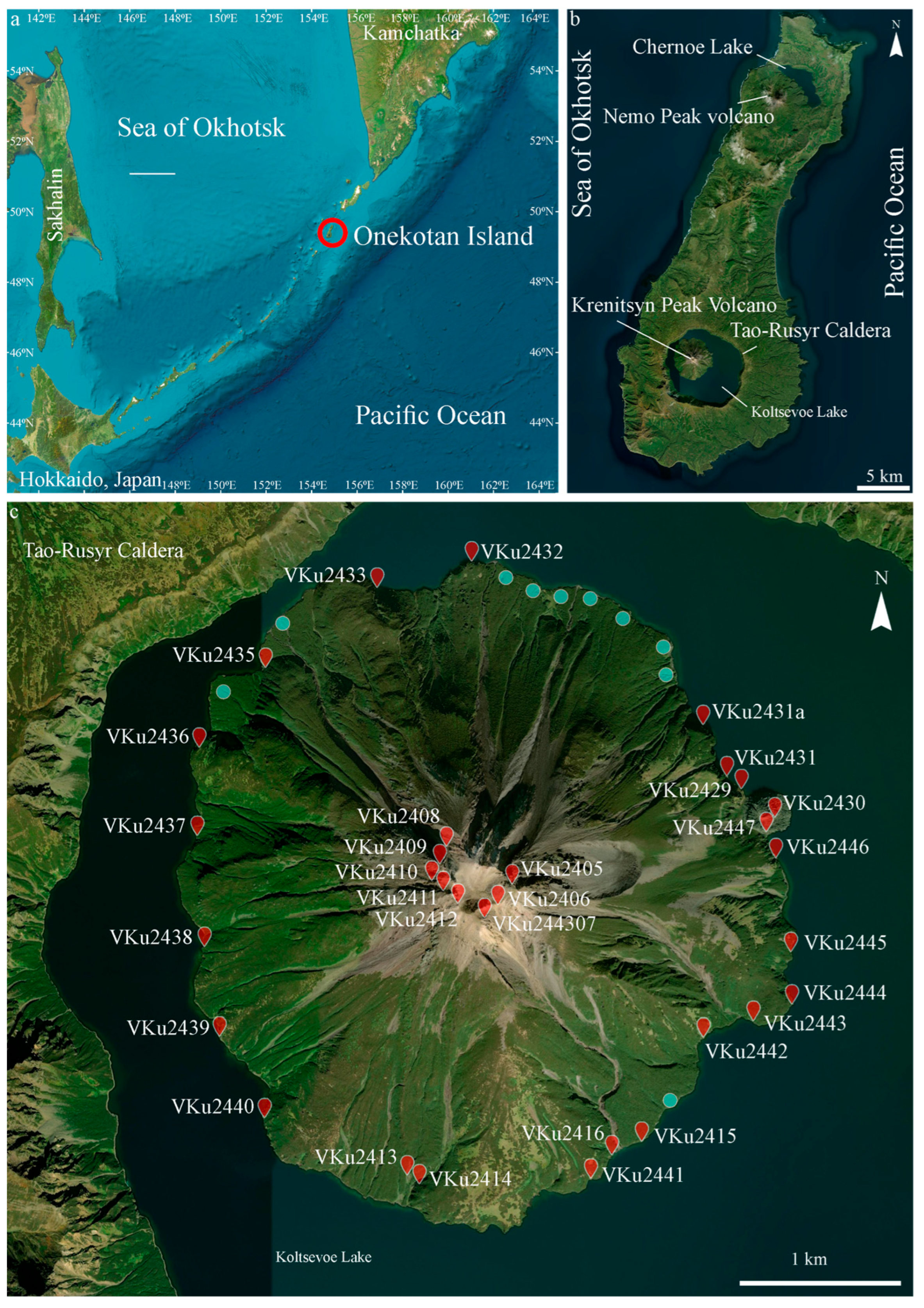


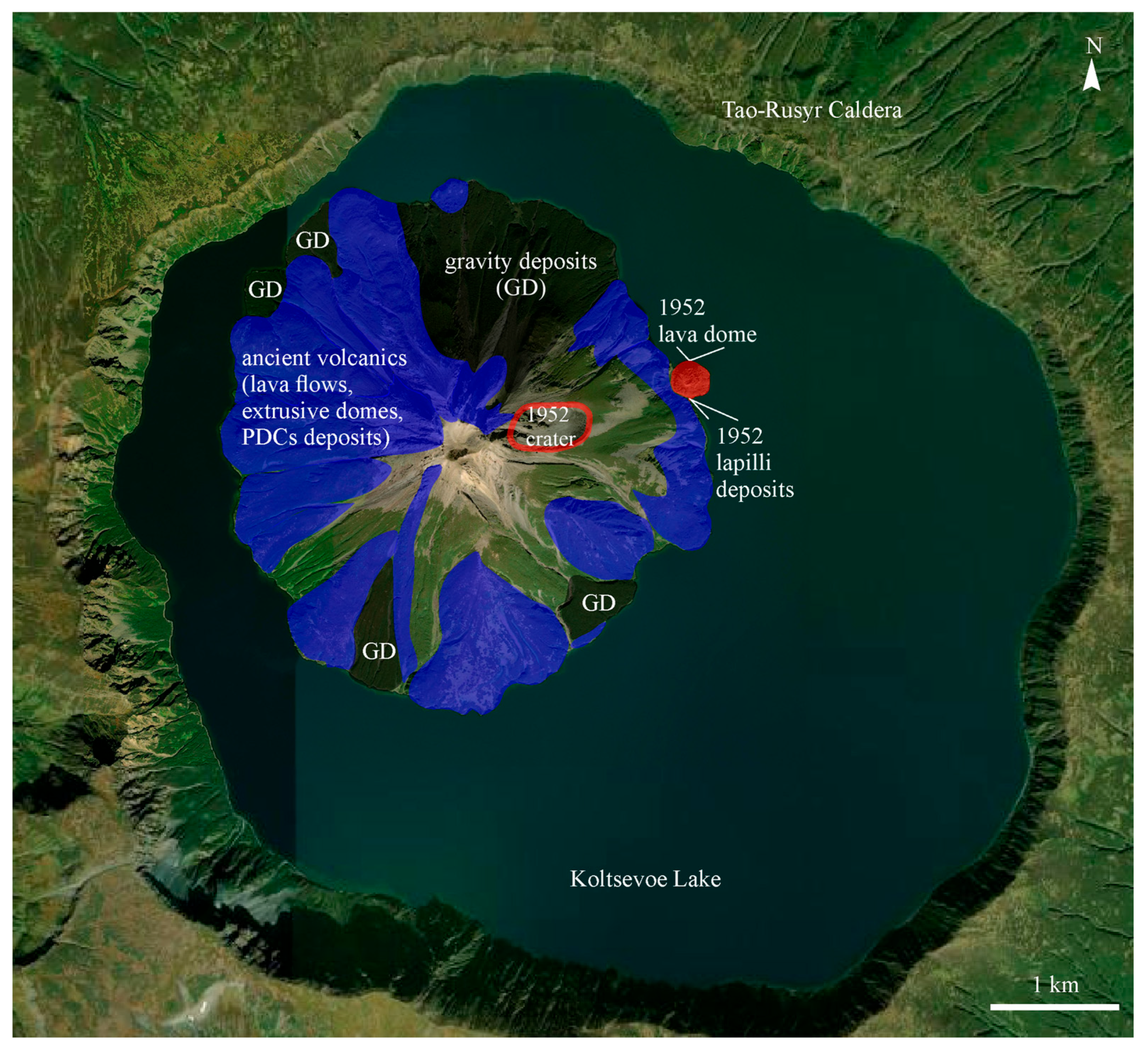
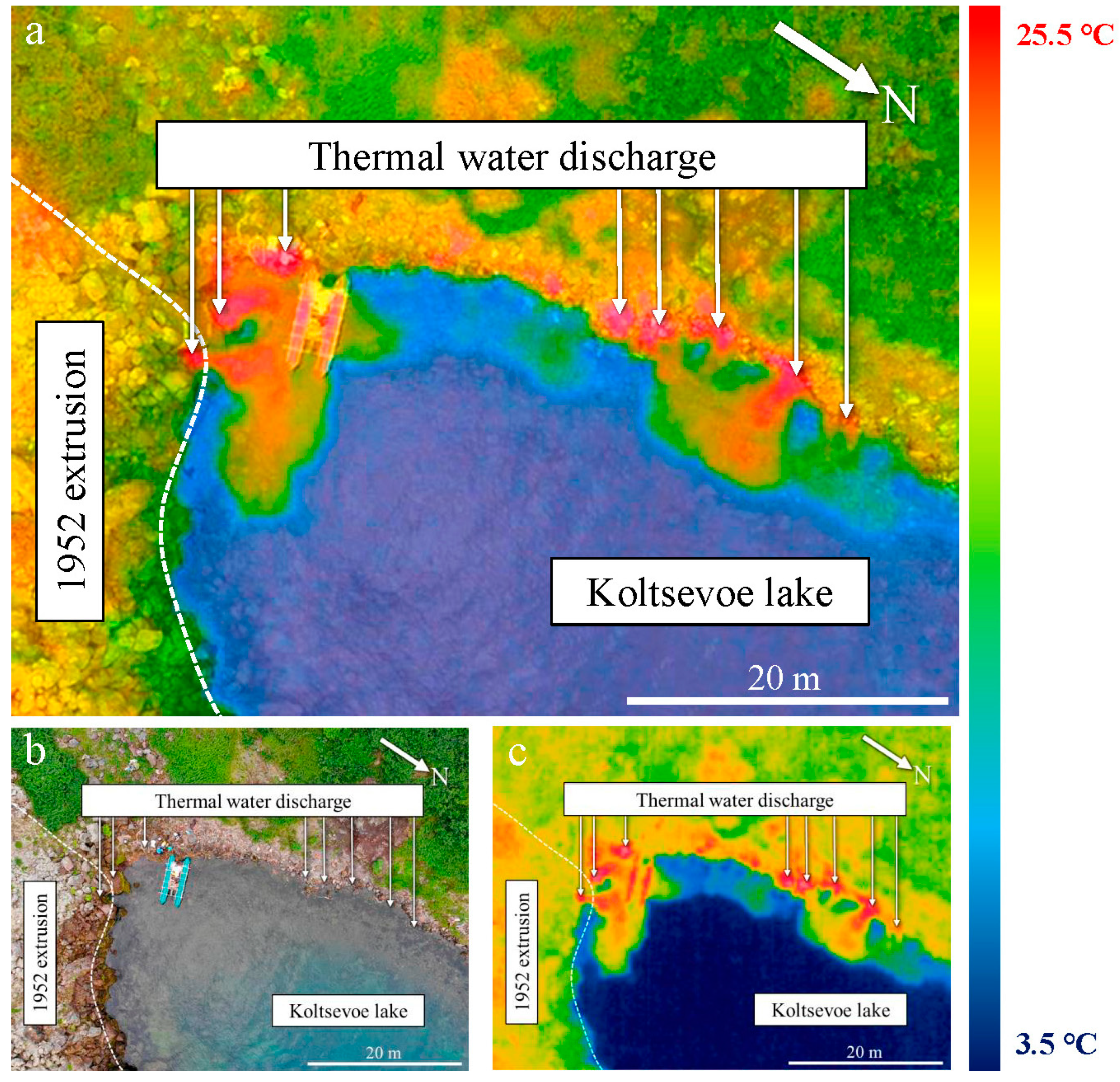

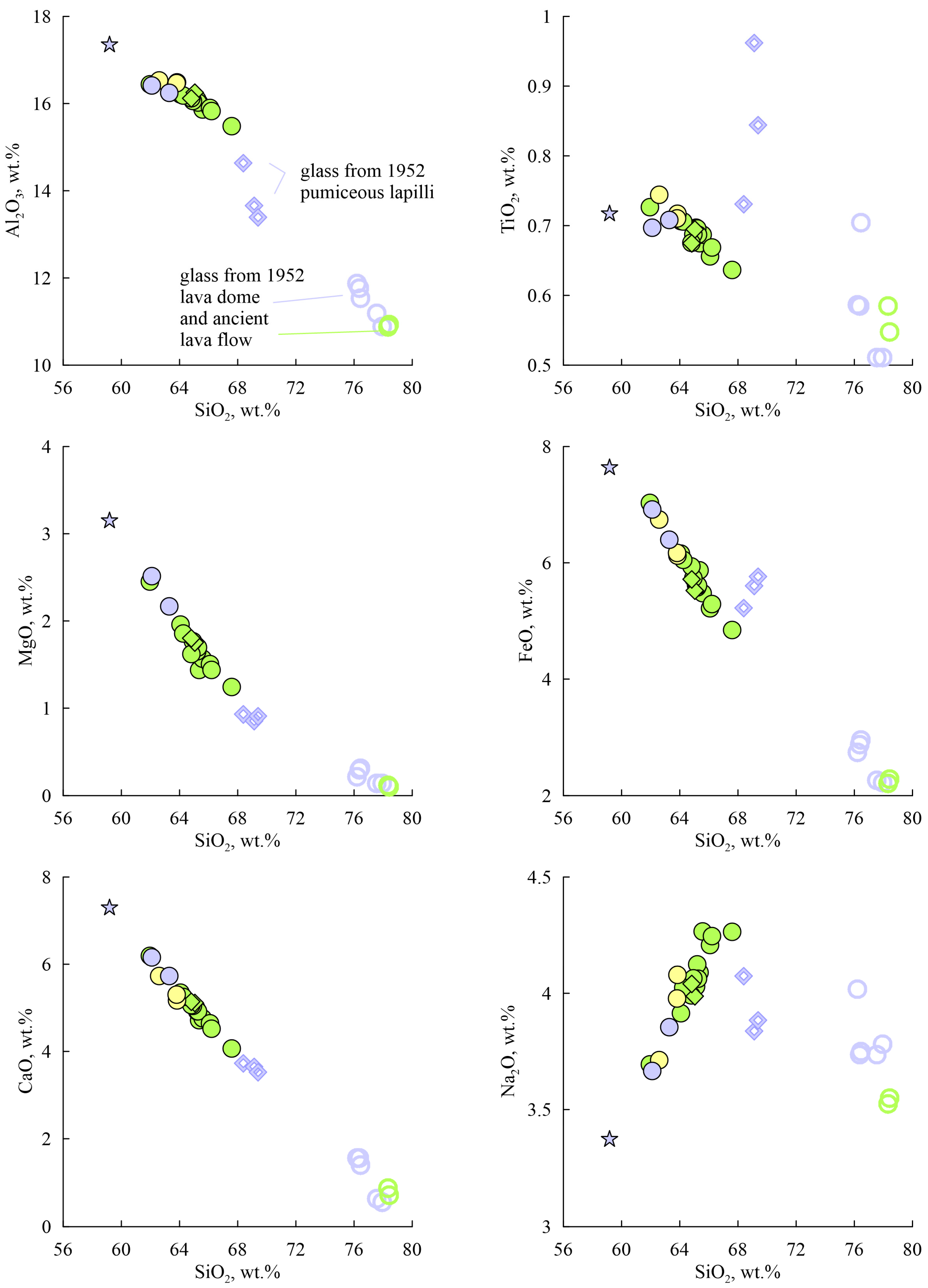
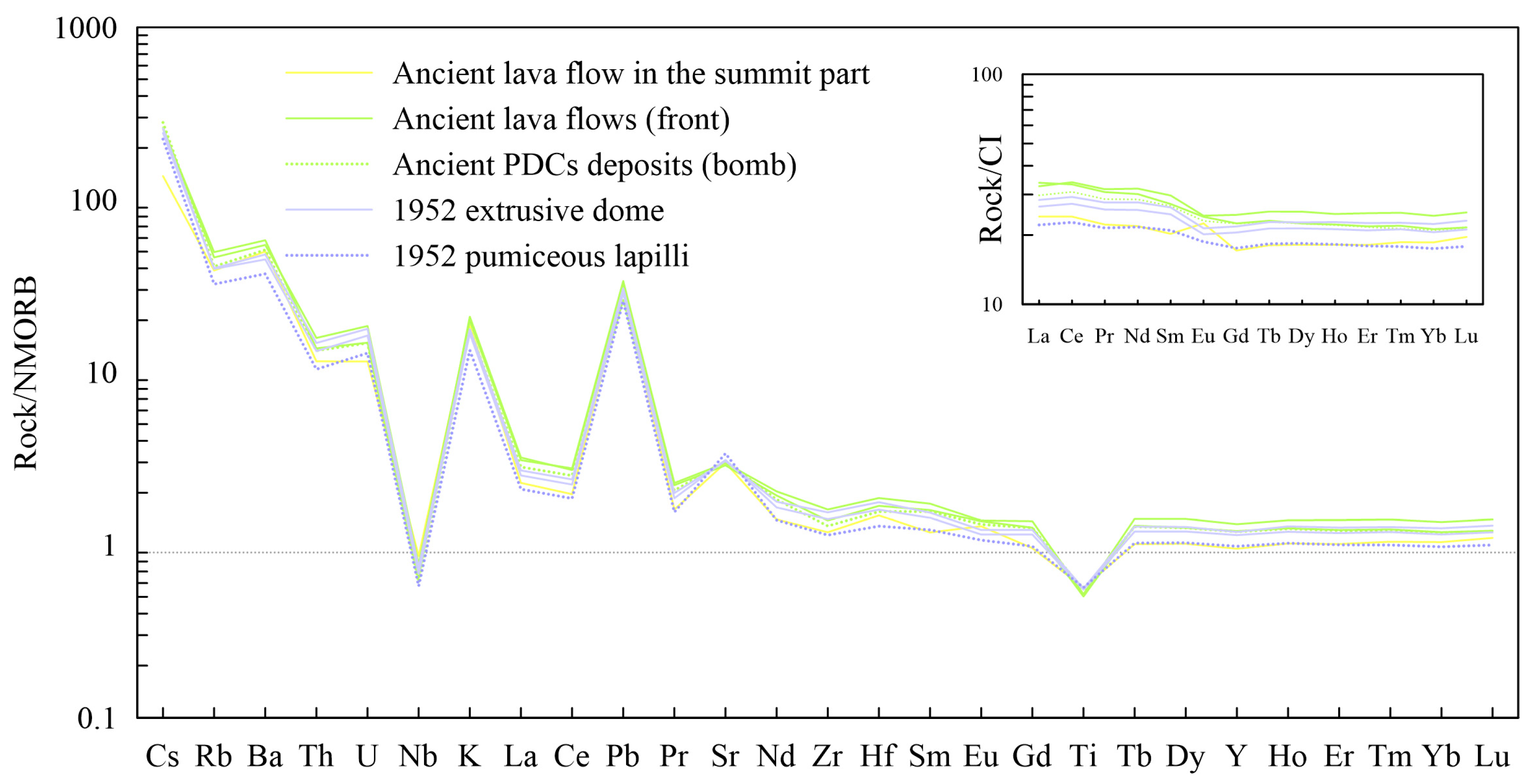

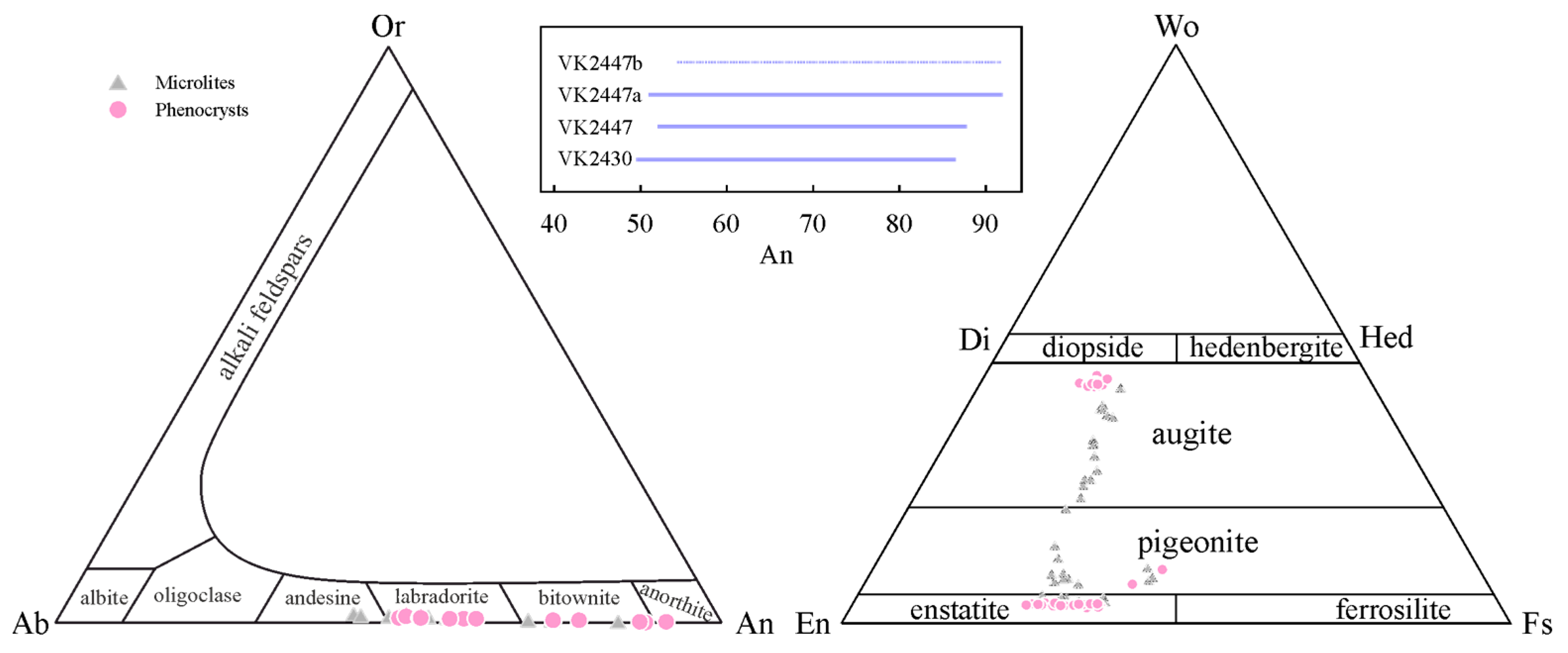
| Sample | VKu2430 | VKu2447 | VKu2447b | VKu2405a | VKu2406a | VKu2413 | VKu2415 |
| Notes | 1952 LD | 1952 LD | 1952 lapilli | ancient LF | ancient LF | ancient LF | ancient LD |
| SiO2 | 62.55 | 61.49 | 58.61 | 63.23 | 61.38 | 63.51 | 61.38 |
| TiO2 | 0.70 | 0.69 | 0.71 | 0.71 | 0.73 | 0.70 | 0.72 |
| Al2O3 | 16.06 | 16.25 | 17.18 | 16.33 | 16.21 | 16.07 | 16.29 |
| FeO | 6.33 | 6.85 | 7.57 | 6.06 | 6.61 | 6.10 | 6.96 |
| MnO | 0.18 | 0.18 | 0.19 | 0.18 | 0.17 | 0.18 | 0.19 |
| MgO | 2.14 | 2.49 | 3.12 | 1.85 | 2.35 | 1.94 | 2.43 |
| CaO | 5.66 | 6.1 | 7.22 | 5.12 | 5.62 | 5.3 | 6.13 |
| Na2O | 3.81 | 3.63 | 3.34 | 4.04 | 3.64 | 3.88 | 3.66 |
| K2O | 1.27 | 1.2 | 0.96 | 1.35 | 1.18 | 1.27 | 1.16 |
| P2O5 | 0.15 | 0.14 | 0.14 | 0.17 | 0.16 | 0.16 | 0.15 |
| Total | 98.85 | 99.02 | 99.04 | 99.04 | 98.05 | 99.11 | 99.07 |
| Sample | VKu2408 | VKu2443 | VKu2443a | VKu2431 | VKu2432 | VKu2433 | VKu2435 |
| Notes | dike | ancient PF (bomb) | ancient PF (ash) | ancient LF | ancient LF | ancient LF | ancient LF |
| SiO2 | 62.89 | 64.60 | 64.33 | 64.88 | 64.89 | 64.48 | 64.66 |
| TiO2 | 0.70 | 0.69 | 0.67 | 0.67 | 0.68 | 0.69 | 0.69 |
| Al2O3 | 16.23 | 16.14 | 16.00 | 15.90 | 15.70 | 15.94 | 15.96 |
| FeO | 6.08 | 5.49 | 5.68 | 5.83 | 5.42 | 5.56 | 5.53 |
| MnO | 0.18 | 0.18 | 0.18 | 0.17 | 0.17 | 0.18 | 0.17 |
| MgO | 1.89 | 1.74 | 1.79 | 1.43 | 1.55 | 1.7 | 1.64 |
| CaO | 5.23 | 5.08 | 5.1 | 4.68 | 4.71 | 4.95 | 4.88 |
| Na2O | 3.92 | 3.96 | 4.01 | 4.06 | 4.22 | 3.99 | 4.09 |
| K2O | 1.28 | 1.27 | 1.33 | 1.45 | 1.43 | 1.34 | 1.36 |
| P2O5 | 0.17 | 0.17 | 0.17 | 0.2 | 0.17 | 0.18 | 0.18 |
| Total | 98.57 | 99.32 | 99.26 | 99.27 | 98.94 | 99.01 | 99.16 |
| Sample | VKu2436 | VKu2437 | VKu2439 | VKu2440 | VKu2441 | VKu2442 | VKu2444 |
| Notes | ancient LF | ancient LF | ancient LF | ancient LF | ancient LF | ancient LF | ancient LF |
| SiO2 | 64.57 | 64.22 | 64.30 | 65.50 | 66.90 | 65.32 | 63.69 |
| TiO2 | 0.68 | 0.68 | 0.67 | 0.65 | 0.63 | 0.66 | 0.70 |
| Al2O3 | 15.85 | 15.89 | 16.00 | 15.76 | 15.32 | 15.62 | 16.04 |
| FeO | 5.55 | 5.68 | 5.89 | 5.17 | 4.80 | 5.22 | 6.00 |
| MnO | 0.17 | 0.17 | 0.18 | 0.17 | 0.16 | 0.17 | 0.18 |
| MgO | 1.68 | 1.75 | 1.61 | 1.49 | 1.23 | 1.42 | 1.84 |
| CaO | 4.87 | 4.99 | 5.02 | 4.6 | 4.03 | 4.46 | 5.2 |
| Na2O | 4.02 | 4.02 | 3.96 | 4.17 | 4.22 | 4.19 | 3.99 |
| K2O | 1.37 | 1.35 | 1.4 | 1.43 | 1.5 | 1.43 | 1.31 |
| P2O5 | 0.17 | 0.17 | 0.19 | 0.18 | 0.19 | 0.18 | 0.18 |
| Total | 98.93 | 98.92 | 99.22 | 99.12 | 98.98 | 98.67 | 99.13 |
| Sample | VKu2430 | VKu2447 | VKu2447b | VKu2443 | VKu2405a | VKu2440 | VKu2441 |
|---|---|---|---|---|---|---|---|
| Li | 6.5 | 8.6 | 9.9 | 9 | 8.3 | 9.5 | 9.1 |
| Be | 0.44 | 0.58 | 0.56 | 0.63 | 0.53 | 0.69 | 0.76 |
| Sc | 32 | 30 | 27 | 23 | 25 | 23 | 20 |
| V | 209 | 175 | 140 | 85 | 99 | 68 | 39 |
| Cr | 4.9 | 5.3 | 3.8 | 0.69 | 4.2 | 1.9 | 2.3 |
| Ni | 3 | 2.8 | 1.9 | 0.47 | 3.1 | 0.8 | 0.56 |
| Cu | 43 | 48 | 24 | 19 | 20 | 18 | 13 |
| Zn | 87 | 82 | 82 | 78 | 81 | 76 | 68 |
| Ga | 17 | 16 | 16 | 16 | 16 | 16 | 16 |
| Rb | 18 | 22 | 22 | 23 | 22 | 26 | 28 |
| Sr | 304 | 279 | 275 | 275 | 268 | 268 | 259 |
| Y | 27 | 32 | 33 | 33 | 27 | 37 | 34 |
| Zr | 84 | 104 | 114 | 95 | 87 | 118 | 102 |
| Nb | 1.3 | 1.6 | 1.7 | 1.4 | 2 | 1.8 | 1.5 |
| Mo | 2 | 2.3 | 2.4 | 1.5 | 2.8 | 2.1 | 1.3 |
| Sn | 0.54 | 1.2 | 0.66 | 0.43 | 0.72 | 0.73 | 0.78 |
| Sb | 0.31 | 0.39 | 0.44 | 0.39 | 0.41 | 0.44 | 0.41 |
| Cs | 1.6 | 1.8 | 1.7 | 2 | 0.96 | 1.8 | 1.8 |
| Ba | 234 | 284 | 303 | 323 | 316 | 345 | 367 |
| La | 5.2 | 6.3 | 6.7 | 7.1 | 5.7 | 7.7 | 8 |
| Ce | 14 | 17 | 18 | 19 | 15 | 21 | 20 |
| Pr | 2 | 2.5 | 2.6 | 2.7 | 2.1 | 3 | 2.9 |
| Nd | 10 | 12 | 13 | 13 | 10 | 15 | 14 |
| Sm | 3.2 | 3.8 | 4 | 4.1 | 3.1 | 4.5 | 4.2 |
| Eu | 1.1 | 1.2 | 1.2 | 1.3 | 1.3 | 1.4 | 1.4 |
| Gd | 3.6 | 4.2 | 4.5 | 4.6 | 3.5 | 5 | 4.6 |
| Tb | 0.69 | 0.8 | 0.85 | 0.85 | 0.68 | 0.95 | 0.86 |
| Dy | 4.7 | 5.4 | 5.8 | 5.7 | 4.6 | 6.4 | 5.7 |
| Ho | 1 | 1.2 | 1.3 | 1.2 | 1 | 1.4 | 1.3 |
| Er | 3 | 3.5 | 3.7 | 3.6 | 3 | 4.1 | 3.6 |
| Tm | 0.45 | 0.54 | 0.58 | 0.54 | 0.47 | 0.64 | 0.56 |
| Yb | 3 | 3.5 | 3.8 | 3.6 | 3.2 | 4.1 | 3.6 |
| Lu | 0.45 | 0.54 | 0.59 | 0.54 | 0.5 | 0.64 | 0.55 |
| Hf | 2.6 | 3.3 | 3.6 | 3.2 | 3 | 3.8 | 3.4 |
| Pb | 7.8 | 8.6 | 9.2 | 8.1 | 9.2 | 10 | 9.8 |
| Bi | 0.186 | 0.05 | 0.031 | b.d.l. | b.d.l. | 0.021 | 0.027 |
| Th | 1.2 | 1.6 | 1.8 | 1.6 | 1.4 | 1.9 | 1.7 |
| U | 0.61 | 0.77 | 0.84 | 0.69 | 0.54 | 0.87 | 0.7 |
Disclaimer/Publisher’s Note: The statements, opinions and data contained in all publications are solely those of the individual author(s) and contributor(s) and not of MDPI and/or the editor(s). MDPI and/or the editor(s) disclaim responsibility for any injury to people or property resulting from any ideas, methods, instructions or products referred to in the content. |
© 2025 by the authors. Licensee MDPI, Basel, Switzerland. This article is an open access article distributed under the terms and conditions of the Creative Commons Attribution (CC BY) license (https://creativecommons.org/licenses/by/4.0/).
Share and Cite
Davydova, V.O.; Nuzhdaev, A.A.; Bolshakov, I.E.; Kuznetsov, R.A.; Ermolinskiy, A.B.; Zhitova, E.S.; Yapaskurt, V.O. Petrology of the 1952 Eruption and Ancient Lava and Pyroclastic Flows of Krenitsyn Peak Volcano, Onekotan Island, Kuril Arc, Russia. Geosciences 2025, 15, 358. https://doi.org/10.3390/geosciences15090358
Davydova VO, Nuzhdaev AA, Bolshakov IE, Kuznetsov RA, Ermolinskiy AB, Zhitova ES, Yapaskurt VO. Petrology of the 1952 Eruption and Ancient Lava and Pyroclastic Flows of Krenitsyn Peak Volcano, Onekotan Island, Kuril Arc, Russia. Geosciences. 2025; 15(9):358. https://doi.org/10.3390/geosciences15090358
Chicago/Turabian StyleDavydova, Vesta O., Anton A. Nuzhdaev, Ilya E. Bolshakov, Ruslan A. Kuznetsov, Andrey B. Ermolinskiy, Elena S. Zhitova, and Vasiliy O. Yapaskurt. 2025. "Petrology of the 1952 Eruption and Ancient Lava and Pyroclastic Flows of Krenitsyn Peak Volcano, Onekotan Island, Kuril Arc, Russia" Geosciences 15, no. 9: 358. https://doi.org/10.3390/geosciences15090358
APA StyleDavydova, V. O., Nuzhdaev, A. A., Bolshakov, I. E., Kuznetsov, R. A., Ermolinskiy, A. B., Zhitova, E. S., & Yapaskurt, V. O. (2025). Petrology of the 1952 Eruption and Ancient Lava and Pyroclastic Flows of Krenitsyn Peak Volcano, Onekotan Island, Kuril Arc, Russia. Geosciences, 15(9), 358. https://doi.org/10.3390/geosciences15090358







